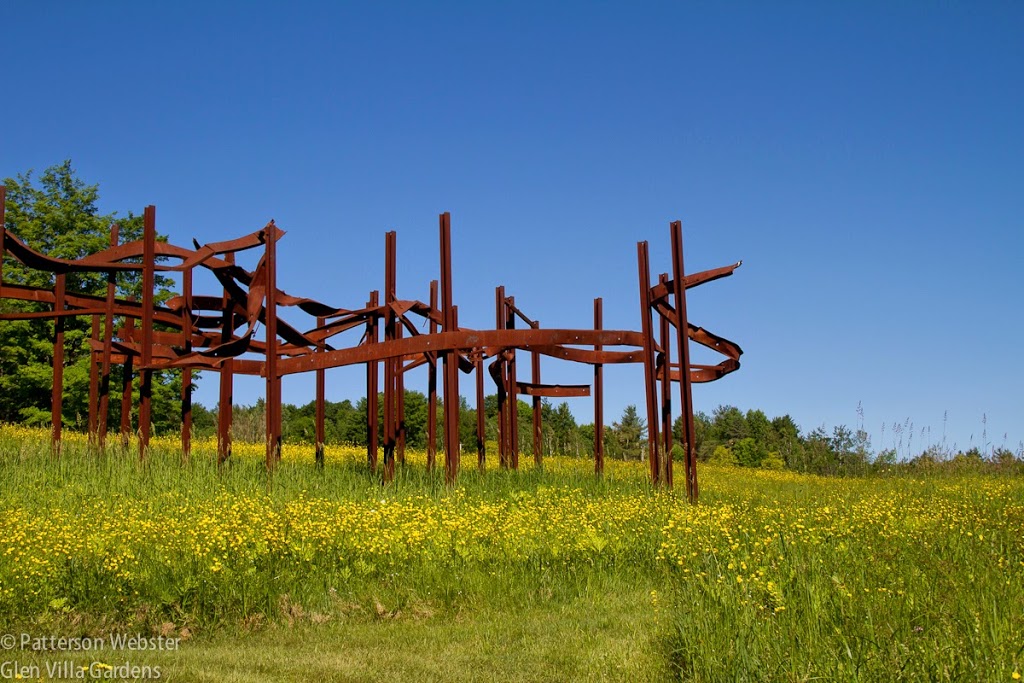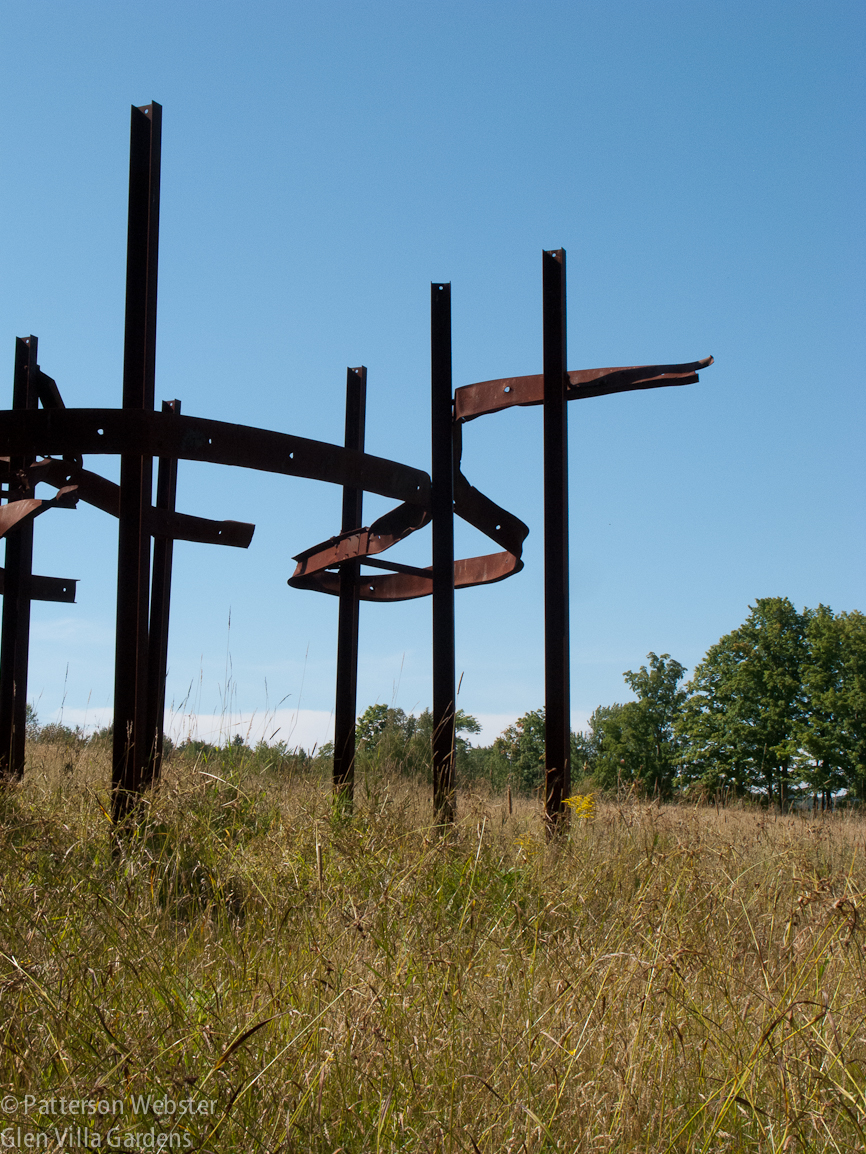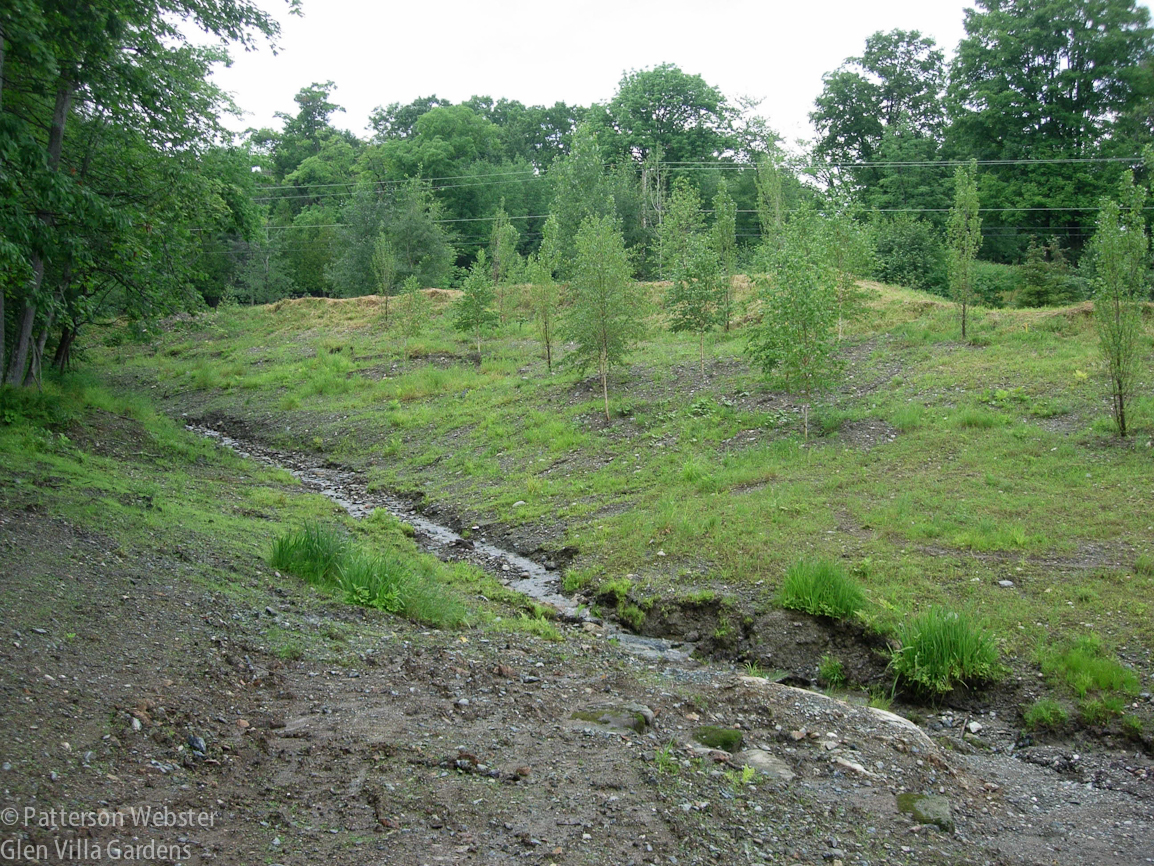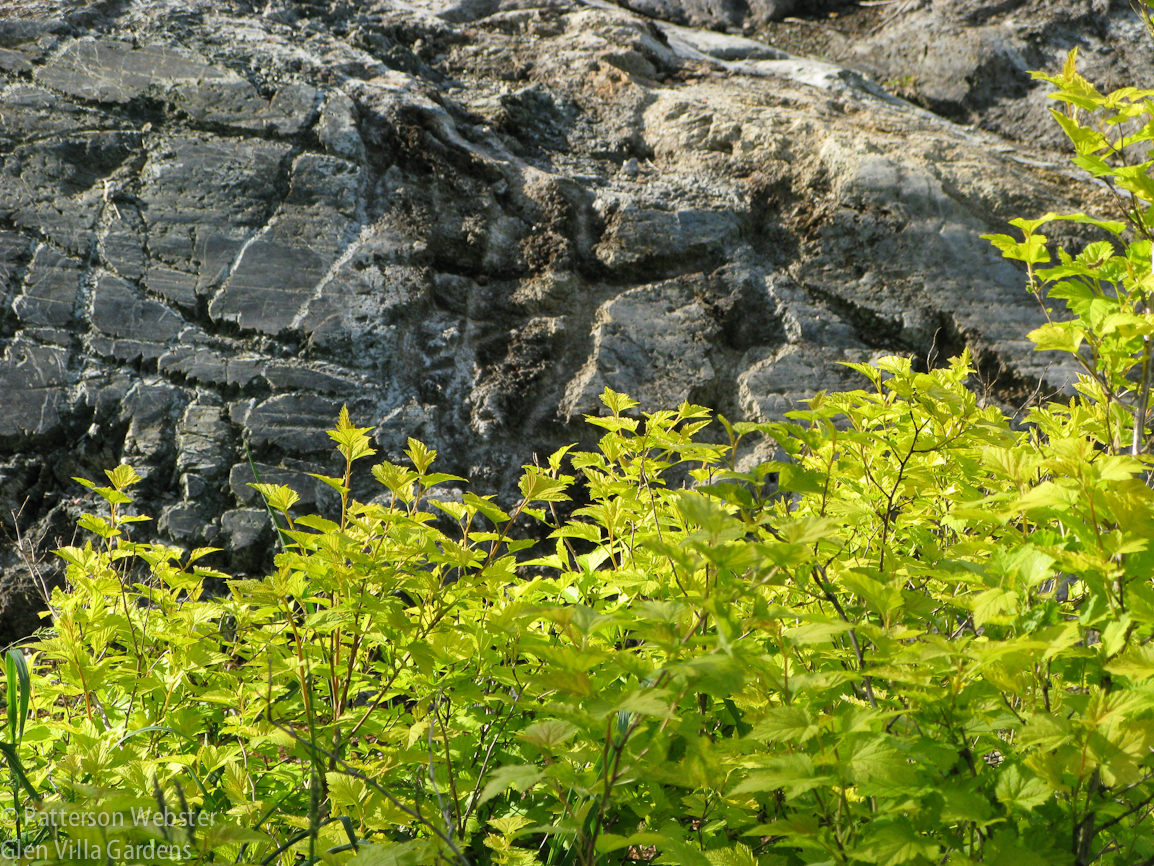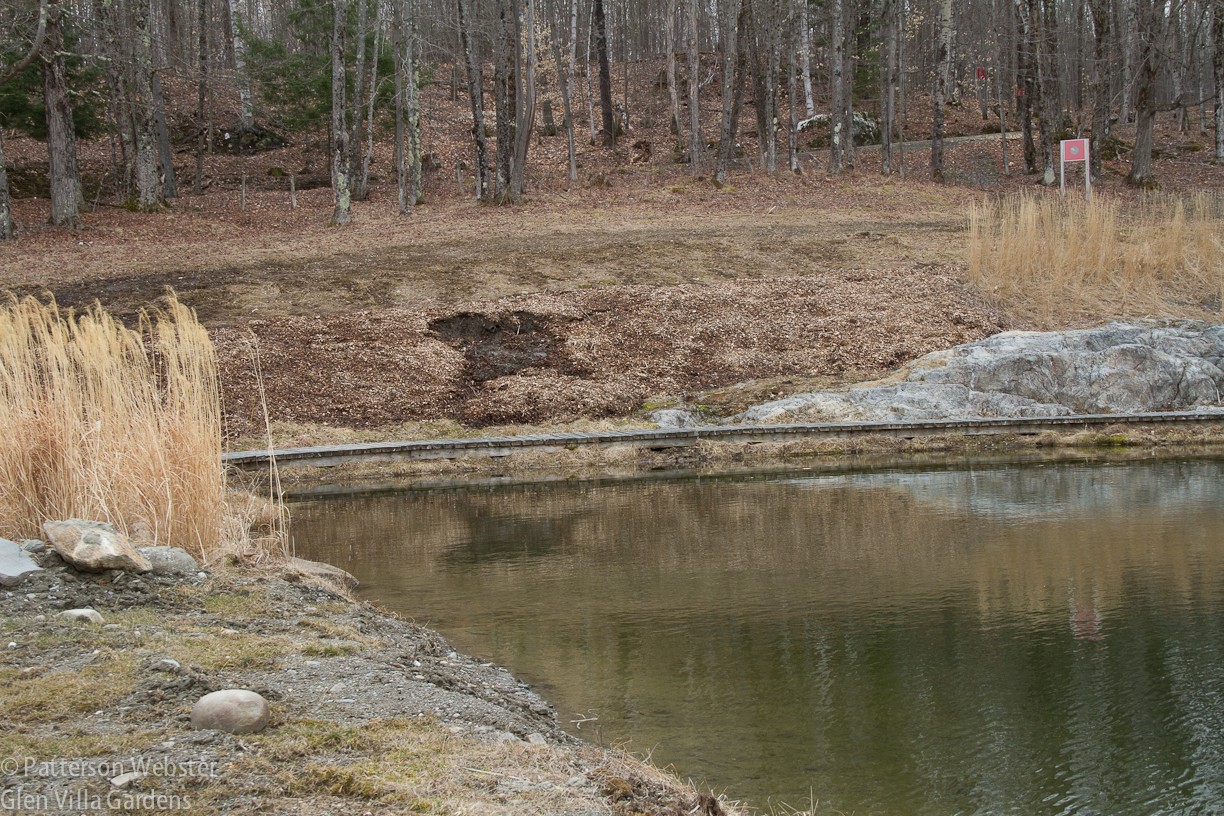The Skating Pond was an accident. I didn’t set out to make a pond, for skating or anything else. But that’s what happened.
The genesis for the project was an old covered bridge that played a part in my husband’s boyhood. In 2001 vandals burned it down.
Seeing the remains, my husband felt as if he’d lost a piece of his past. So we asked our friends, the sculptors Louise Doucet and Satoshi Saito, to resurrect the twisted pieces of steel that by that time were supporting the bridge. The result is a large sculpture that sits in the Upper Field, in a spot where sloping land forms a bowl that holds the piece in place visually.
We were delighted with the results — and with the name that Louise and Satoshi gave the piece, Bridge Ascending. Raising the twisted pieces of steel into the air transformed them from junk metal into a work of art. It made them into a bridge again, albeit a bridge over rippling grass rather than rippling water. Unfortunately, it also meant that the sculpture was visible from the road – so visible that we were afraid it would cause an accident as people screeched to a stop to see what those crazy Websters were up to now.
Creating the Pond
To hide the sculpture from the road, we decided to make a berm near the road. Pushing dirt from the field into the berm, or large hill, we discovered hidden treasures: clay soil, water and some stunningly beautiful rock.
This excited me. The field near the road was a part of the property that no one used, because there was no reason to go there. But clay soil and water equaled a pond, and with the bedrock beside it, I knew that an uninteresting piece of ground could become something special.
We began to dig in the fall of 2003; a year later the pond wasn’t finished but, as I wrote in my garden diary, “it does provide a sunny area for wetland plants and a reason to walk to the upper field.”
By the end of 2005, we had uncovered more of the blue-grey rock, power-washed it and added a boardwalk over ground that was always wet.

I was standing on the berm and looking down on the pond,when I took this photo. The boardwalk curves around rock, ending at a small stream that is the sole source of water for the Skating Pond.
Planting the Pond
I wanted the area to look natural and didn’t plan on adding many plants. But we did need trees, and willows were an obvious choice for water’s edge. On the berm we added some hardwoods, some evergreens and some poplars that I knew would grow quickly.
Any thought of not adding other plants fell by the wayside in 2006 when I saw some chartreuse-leafed ninebark (Physocarpus opulifolius ‘Golden Nugget’). I knew the shrubs would look splendid beside the blue-grey rock, and they did.
I also planted some feather reed grass (Calamagrostis acutiflora ‘Karl Foerster’) at one end of the pond where the ground looked rough and raw.
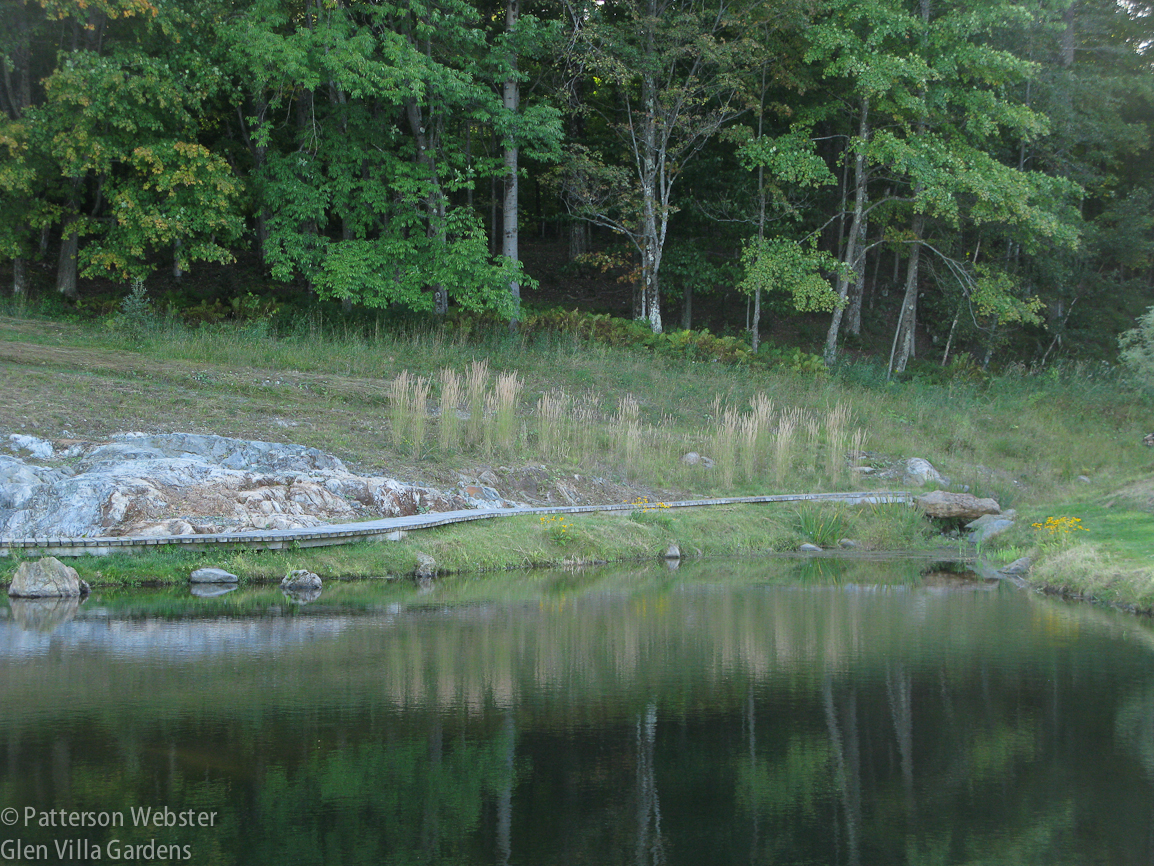
I must have taken this photo at the end of the day in low light. The 16 grasses I planted looked a bit sparse but I thought they would grow to fill the space.
I dug some yellow flag iris from a neighbour’s pond (with her permission, thank you, Ann!) and transplanted a mass of old orange day lilies being shaded out in another part of the garden into a crescent beside the water’s edge.
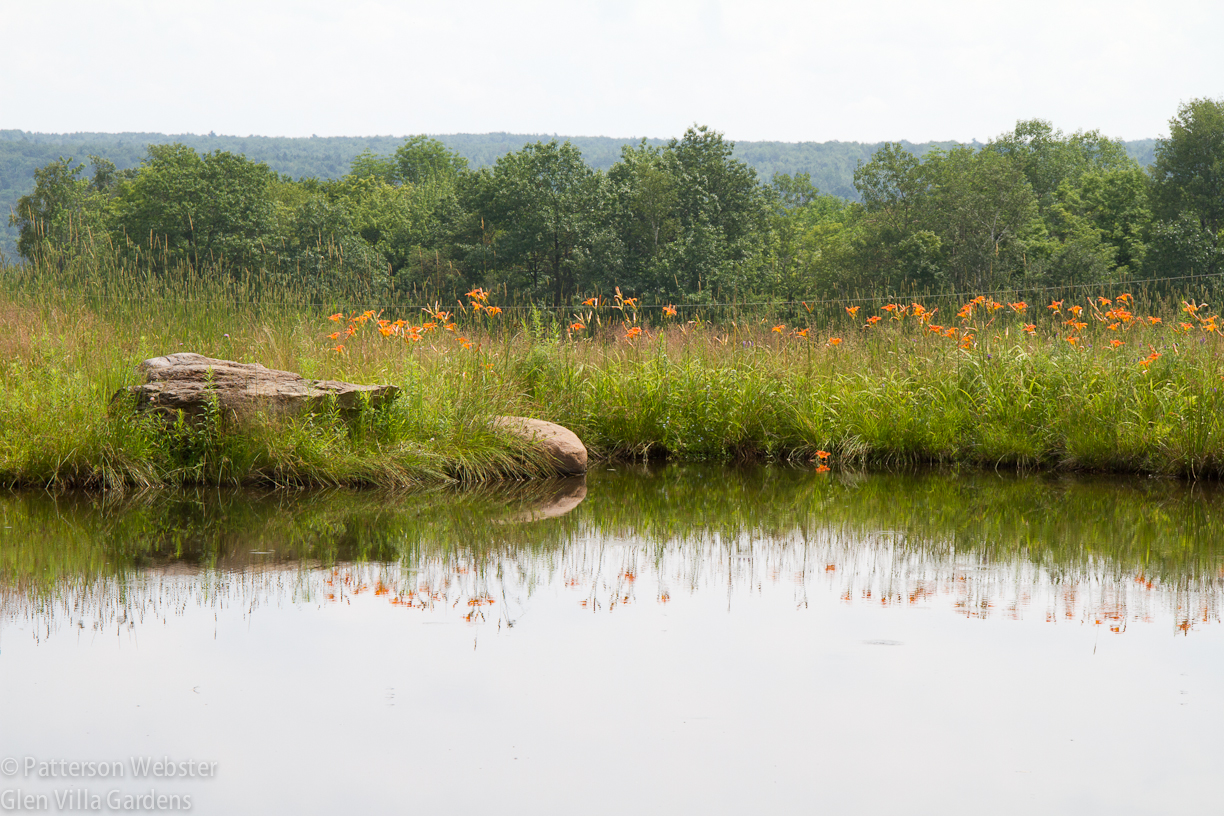
This patch of day lilies bloomed wonderfully until I put deer fences in the Upper Field. Denied tasty shrubs, the deer now eat the day lily buds.
I added iris in a damp spot beside a rock near the start of the boardwalk.
Rudbeckia caught my eye and I scattered clumps of ‘Goldsturm’ near the water. I added some helenium, some achillea, more iris varieties to extend the blooming season, more Calamagrostis ‘Karl Foerster’ and, with only a little trepidation, three horsetail or scouring rushes (Equisetum hyemale) in a spot where nothing would grow.
In other words, I went plant crazy.

This photo dates from 2011. The masses of ninebark and Calamagrostis are too evenly balanced but apart from that, this side of the pond looked pretty good from a distance. Up close it looked a little messy but nicely natural. The red sign in the background marks the beginning of an art installation I created, called In Transit/En Route.
The best thing, though, was not what I planted but what nature planted on its own. From the first year, wildlife began to appear — turtles, frogs, baby ducks, foxes (not a good combination for the baby ducks, I’m afraid), dragon and damsel flies, skimmers, water bugs of all sorts. (And deer, of course. Always deer.) Wildflowers began to grow — ragged robin, buttercups, forget-me-not, some kind of scabious whose seeds I collected alongside a highway.
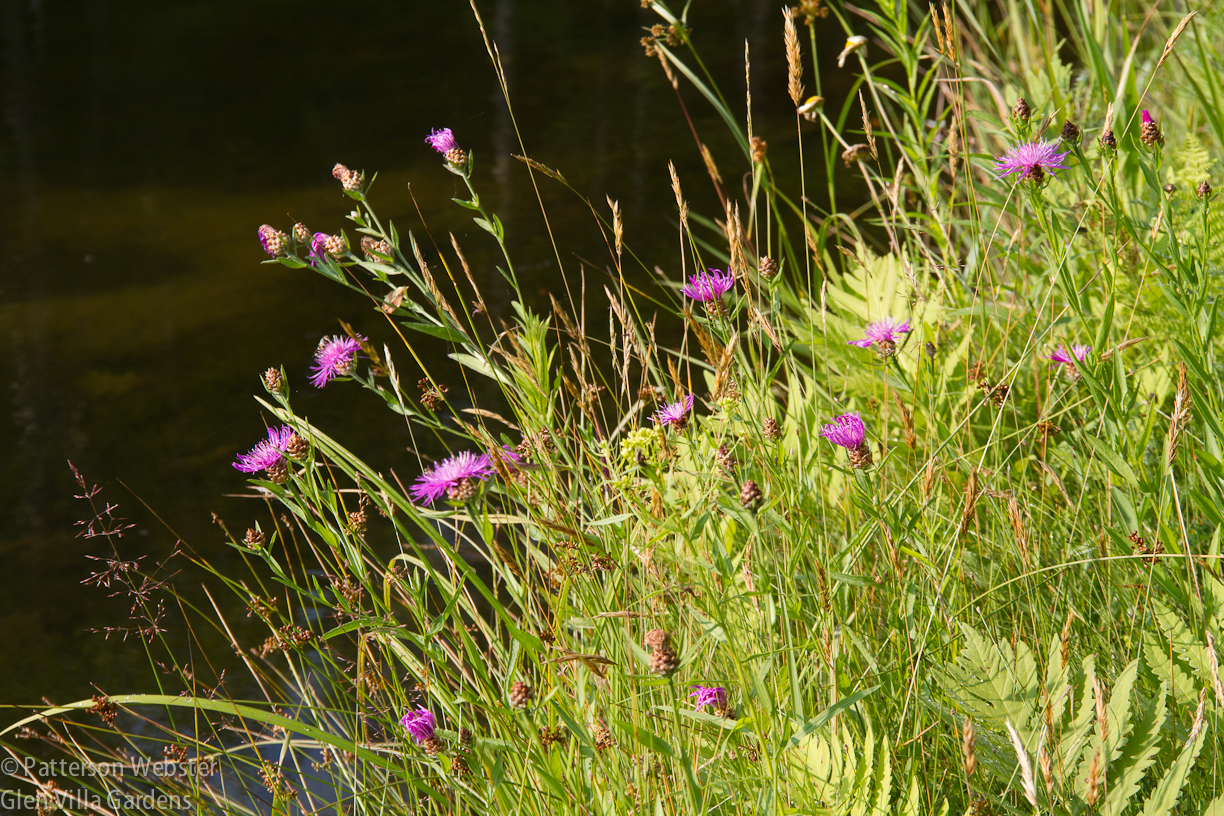
Seeds I scattered son the berm liked it there. Now they are growing alongside the water and have spread so profusely that in some places the ground looks blue.
Problems and Solutions
By 2012, the pond was beginning to silt up. It was time to drain and dredge, and that meant bringing in heavy equipment. With equipment on site, the opportunity to make changes seemed too good to miss. Why not put more rocks in the water? Why not modify the slope above the boardwalk, connect a piece of stagnant water to the pond and enrich the soil where nothing liked to grow?
The far end of the boardwalk, where I first planted Calamagrostis, still looked rough and raw. I dug several clumps of Joe Pye weed from a near-by field. It was August and the plant wilted immediately, but that didn’t worry me. If it liked the location, it would come back and seed itself.
The trick in gardening (and in many other parts of life) is knowing when to stop. I haven’t learned.
I moved the ninebark into the newly built deer fence borders (which I wrote about here, where they are growing extremely well, thank goodness), modified the slope and added more Calamagrostis to hold it in place. Unfortunately, the grasses failed to do the job. It wasn’t their fault — changing the slope had unearthed an underground spring.
The bank began to collapse.
Repairing the damage seemed easy enough — dig up the grasses, add some rocks to hold the slope in place, replant the grasses and add some more.
Last July, after the slope slipped again, we dug down farther, exposing bedrock and making a small channel for the natural spring. The slope needed a few more rocks to hold it in place and we added those last July.
Once we washed off the rock, the section looked bare but I knew the grasses would fill in.
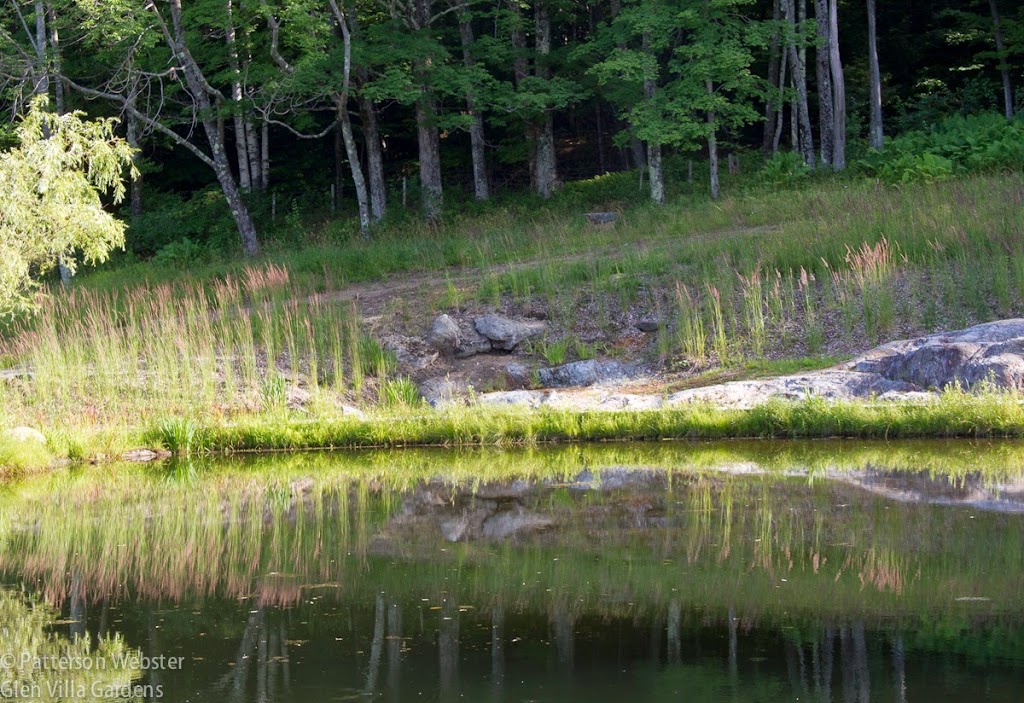
Looking across the pond, you can see the new rocks and the grasses surrounding the section that collapsed.
Evaluating the Results
A hard look at the Skating Pond as it is today tells me that there are a whack of problems that need to be solved.
1. Too much of a good thing is not a good thing.
The grasses have done more than fill in. Looking across the pond, it is clear that there is too much Calamagrostis and not enough anything else.
The area at the beginning of the boardwalk, shown at the far left in the photo below, is part of the problem. The willow tree looks like it is being swallowed. It needs space in front to breathe.
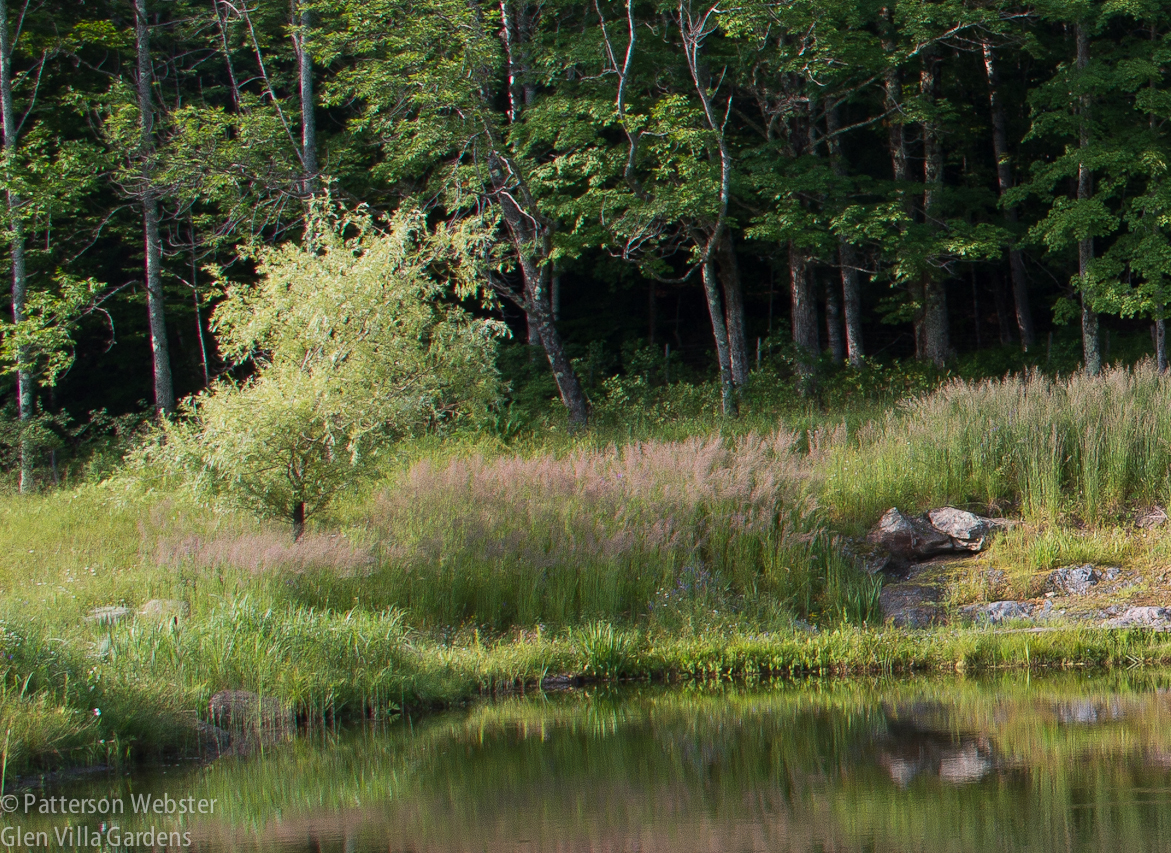
I’ve noticed that the inflorescence of these ornamental grasses appears pinker when the plants are young.
Removing some of the ornamental grasses will change the shape of the curve and create holes which I will need to fill. Darmera grows well for me and I think the contrast of leaf shape, texture and colour would add interest. I worry, though, that there isn’t enough shade. Wilting darmera is not attractive.
2. Too much of a bad thing is a bad thing.
The mess is everywhere, a jumble of deliberately chosen and self-seeded plants. A good clean-up will take care of some of the problem and return the rock to its original beauty. Or so I hope.
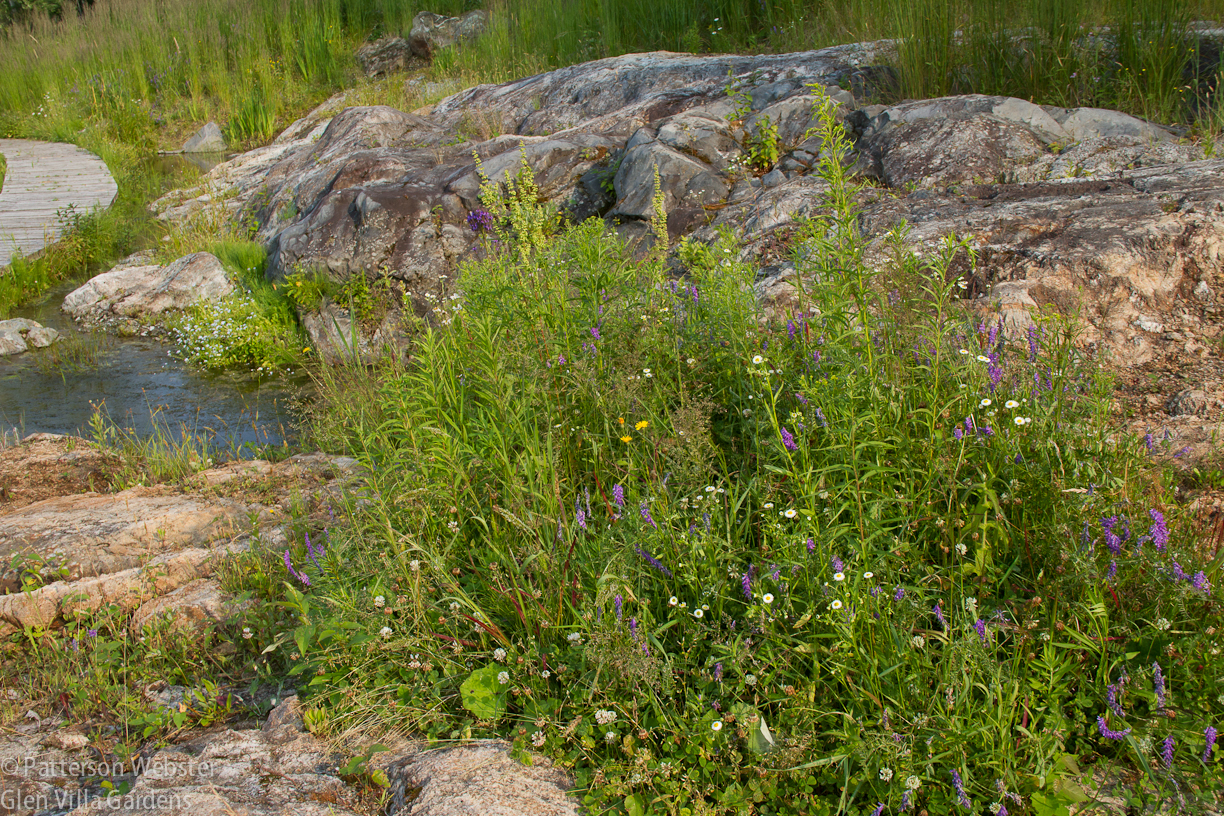
Hidden in this mess of plants are several clumps of Japanese blood grass (Imperator cyindrica ‘Red Baron). Their red blades looked fabulous against the grey rock but they aren’t strong enough to stand up to the competition.
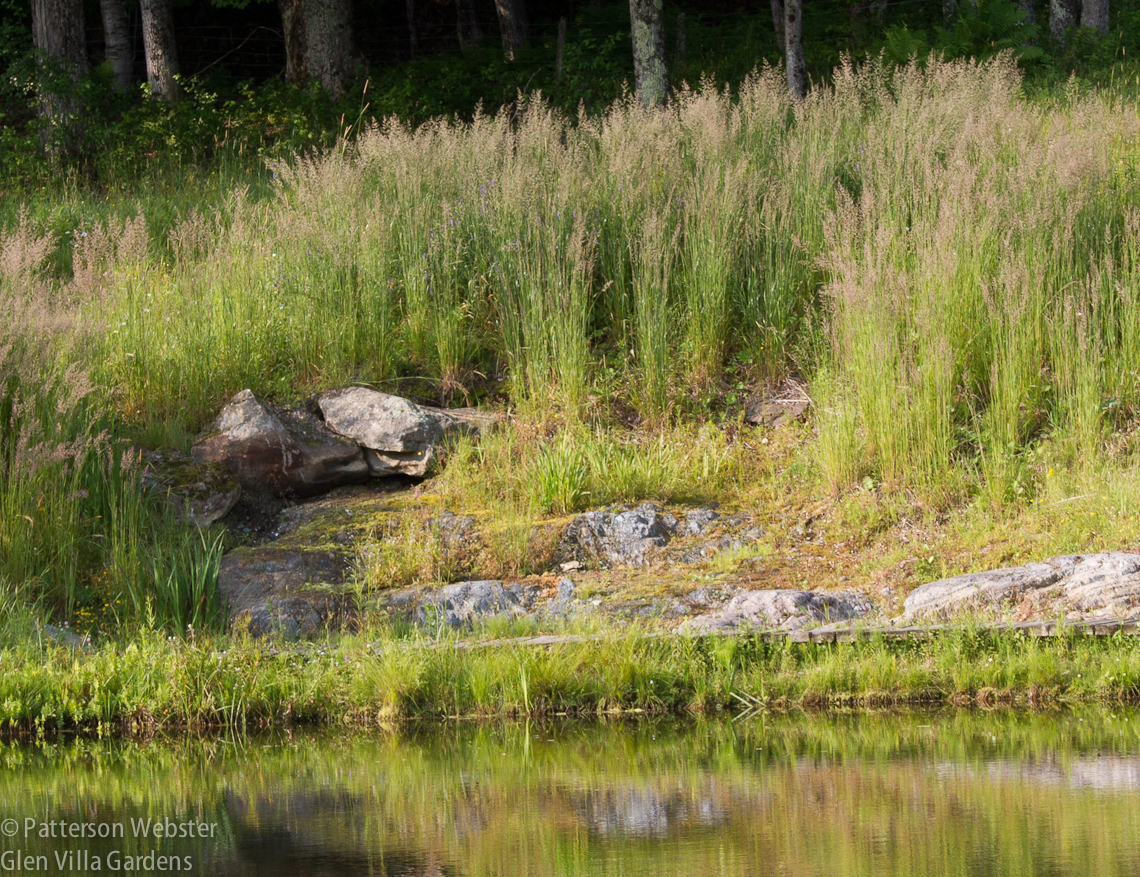
The rocks that look a bit unnatural in this photo are there to hold up the bank behind. They might be better if they were lower but they are sitting on bedrock and can’t go down any more. Smaller rocks won’t hold up the bank.
4. Plants that aren’t growing well make room for more mess.
The rough area at the far end of the boardwalk does not look happy. A few Joe Pye weed plants are showing their heads but after two years there are not enough to make me confident that the plant will thrive and spread as I hoped.
I could dig up this area, add better soil and replant. But it is naturally wet and I know that digging here will only create more problems. I need to find a solution that involves minimal change. I’m wondering if willows will do the job.
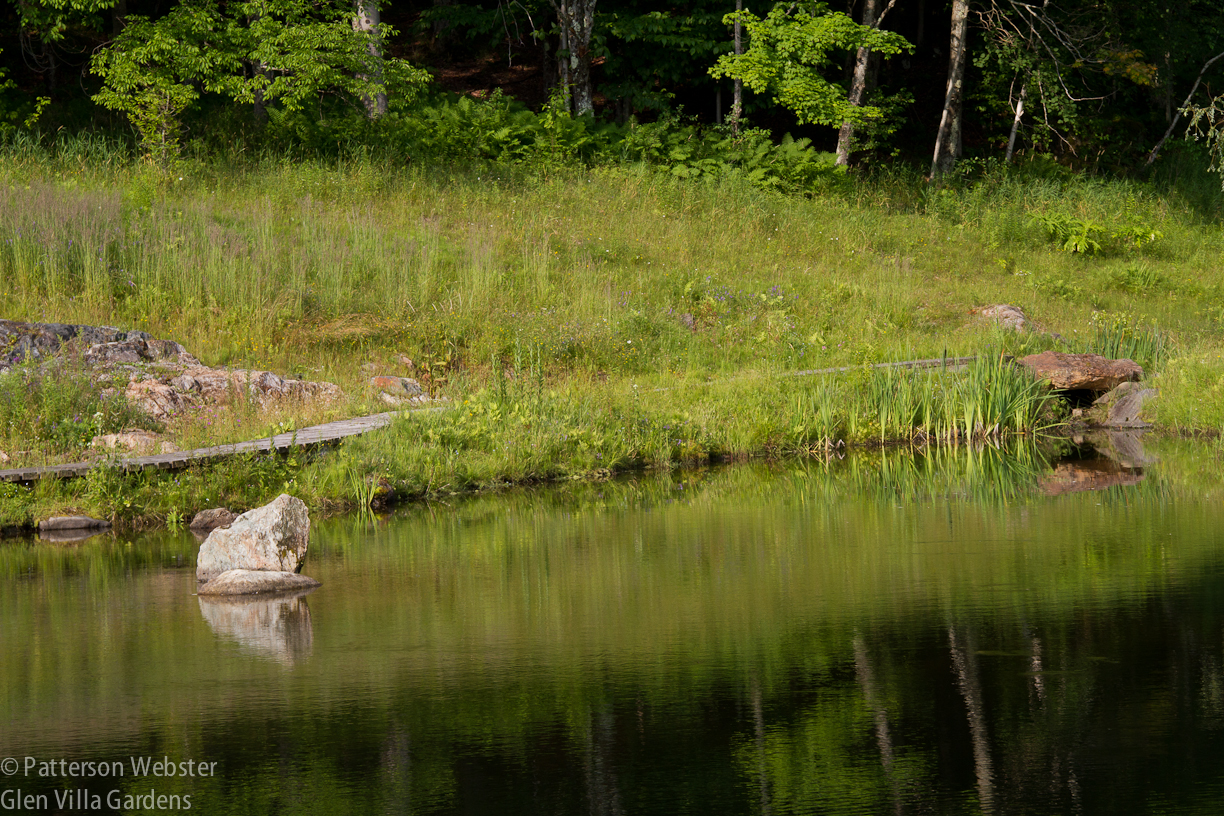
The soil here is not good. I could enrich it before planting again. Or I could leave it to fill in on its own.
5. Things keep growing.
The poplars that I worried were a mistake when planted (Populus nigra Italica) have grown out of scale with the surroundings. Last fall I topped two and kneecapped a few more; they are growing back so quickly that I wish had kneecapped them all. With more topping this fall, I think the relationship between the height of the trees and the surroundings will be restored.
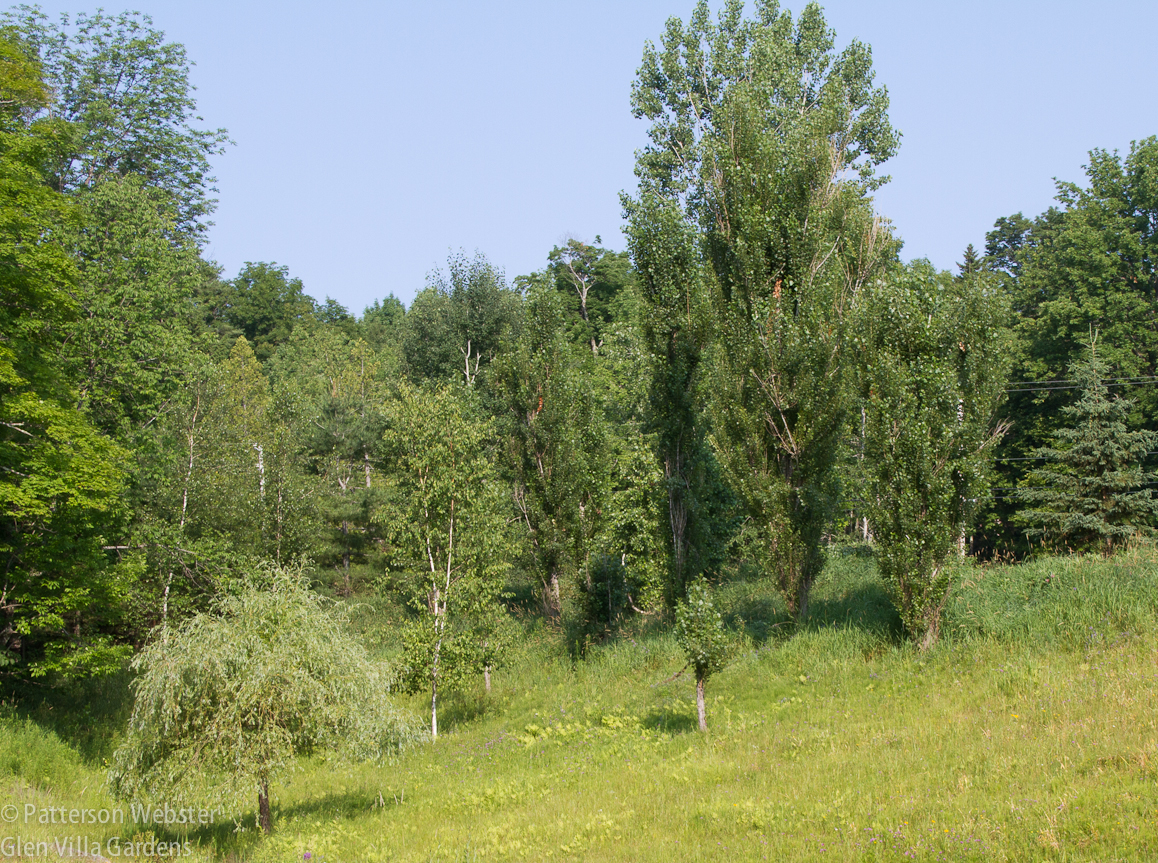
I cut the poplars to different heights. In the back is one that I left alone, in case the topping didn’t work. In the front is one I cut below knee level. It is bushing out remarkably.
Restoring balance in the pond itself will be harder. Even though I threw out the three horsetail reeds after only a year, they spread and are now growing in a shallow area of the pond. At the moment they look nice, but I can see that they will become an error that is hard to correct.

If I could confine the horsetail to this part of the pond, it might be ok. But I think they will gradually spread beyond the pond, through the field and into the world at large.
A Note about the Name
My friend and right-hand man Jacques Gosselin named the Skating Pond when we were well into construction. Weeks of pushing dirt into a berm, adding rocks here and there and generally making a mess had my husband worried. Would the work ever end, and would the results be worth it? The two men used to play hockey together and Jacques believed, quite rightly, that the idea of skating on the pond would minimize, if not alleviate, my husband’s complaints.
He was right. But the story doesn’t end there.
The first winter we cleared the snow from a small area and tried to flood the surface to make the ice smooth enough for skating. After several hours with not much accomplished, both men remembered that a perfectly good outdoor rink was located not far down the road.
No one skated on the pond then, and no one has ever since. But the name has stuck.


